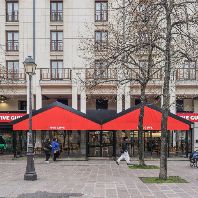While there are signs that demand for other retail asset classes is now dampening, the relative yield discount offered by shopping centers will lead to a further strengthening of demand for this asset class, particularly from UK funds. This will put further downward pressure on shopping center yields over the coming months, albeit with the focus primarily on prime product.
Supply remains a key constraint to transactional activity in the shopping centre market. UK banks are keen to explore alternatives to a straightforward disposal of assets in or nearing distress and, with the relative shortage of buying opportunities remaining in the near term, values on secondary assets will continue rising.
Requirements for strong London locations from retailers and restaurant operators are increasing, and will revive rents both in London's high streets and shopping centers. This will spread to prime provincial locations, but recovery remains some way off for secondary pitches or towns. Continuing the trend of the last two years, shopping centre lease terms will become increasingly flexible but we anticipate some stabilization in landlords' favor in under-supplied locations.
Market commentary
The improvement in activity seen in the last quarter of 2009 continued in Q1 with a total sales volume of £656m, broadly in line with the Q4 total. Significantly, eleven deals made up the Q1 total, the most transactions in any quarter since 2007, and covered a broad range of assets in terms of quality and lot size.
The headline deal of the quarter was Meyer Bergman Retail Partners' long anticipated £130.0m purchase of a 50% stake in the 669,000 sq ft Bentall Centre in Kingston-upon-Thames from Aviva. The shopping center provided the market with concrete evidence of current pricing for top-end assets, reflecting a net initial yield of 5.75%.
As predicted last quarter, secondary assets became the focus of activity in Q1 as the sustained improvement in investor sentiment met with a continued shortage of prime buying opportunities. Examples included Rockspring's purchase of St Tydfil Square, Merthyr Tydfil for £24.0m (NIY 9.50%) and the sale of Salford Shopping Centre, Manchester by Prime Commercial Properties to Praxis Holdings for £40.0m (NIY 9.00%).
Consequently, Q1 brought a second consecutive quarter of yield compression for secondary assets. Both good secondary and secondary assets saw a shift of 50bps to 7.50% and 8.50% respectively, with the market now able to judge pricing on the back of transactional evidence as opposed to sentiment. Despite the occupational risks, investors are recognizing opportunities to obtain greater yield in a sector where average values more than halved during the downturn.
A broader range of investors are now active in the market, and this was reflected in the Q1 purchaser profile. Having been largely absent in 2009, private property companies accounted for 27% of Q1's total volume, albeit activity remains dominated by the funds, who collectively accounted for 57% of Q1 turnover.
A shortage of supply remains an enduring theme in the market, with only seven assets available at end Q1 with a combined quoted sales value of £579m. Importantly, however, £290m is accounted for by William Ewart's Prime London Shopping Centre Portfolio, comprising Victoria Station, Fulham Broadway and Hammersmith Broadway. These prime London assets came to the market in March and are expected to attract strong interest.
Of the seven assets under offer at the end of Q1 2010, Matterhorn Capital's O2 Shopping Centre in north London (NIY 6.15%) and Delancey's Arc, Bury St Edmunds (NIY c.5.75%) best illustrate the current strength of demand in the market.
According to IPD, average shopping centre values have risen by 7.8% in the last six months but are still lagging other key sectors. Occupationally, the picture is also improving. Rental values are close to stabilizing, with a decline of less than -0.1% recorded in the month of February. Nevertheless, the outlook for consumer expenditur













